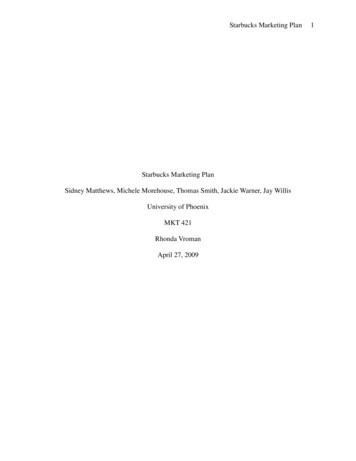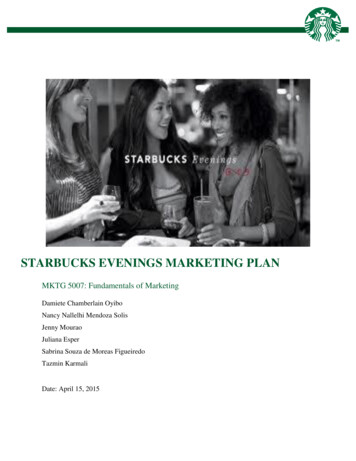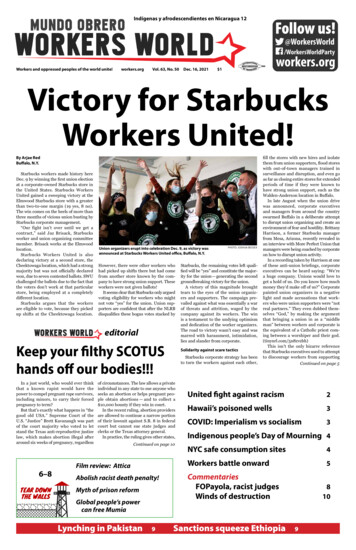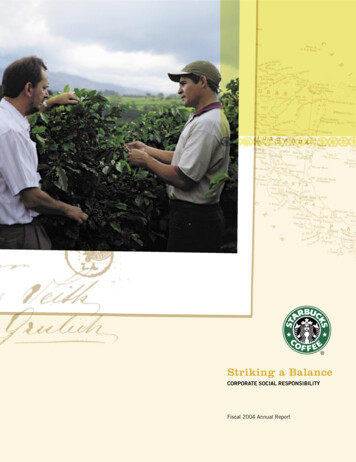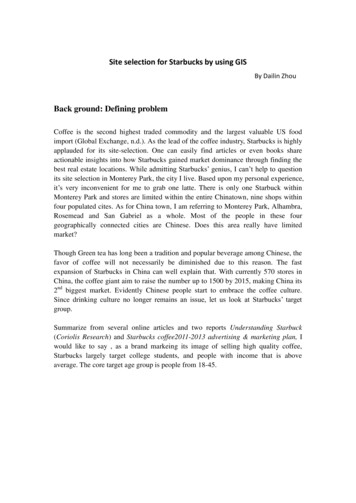
Transcription
Site selection for Starbucks by using GISBy Dailin ZhouBack ground: Defining problemCoffee is the second highest traded commodity and the largest valuable US foodimport (Global Exchange, n.d.). As the lead of the coffee industry, Starbucks is highlyapplauded for its site-selection. One can easily find articles or even books shareactionable insights into how Starbucks gained market dominance through finding thebest real estate locations. While admitting Starbucks’ genius, I can’t help to questionits site selection in Monterey Park, the city I live. Based upon my personal experience,it’s very inconvenient for me to grab one latte. There is only one Starbuck withinMonterey Park and stores are limited within the entire Chinatown, nine shops withinfour populated cites. As for China town, I am referring to Monterey Park, Alhambra,Rosemead and San Gabriel as a whole. Most of the people in these fourgeographically connected cities are Chinese. Does this area really have limitedmarket?Though Green tea has long been a tradition and popular beverage among Chinese, thefavor of coffee will not necessarily be diminished due to this reason. The fastexpansion of Starbucks in China can well explain that. With currently 570 stores inChina, the coffee giant aim to raise the number up to 1500 by 2015, making China its2nd biggest market. Evidently Chinese people start to embrace the coffee culture.Since drinking culture no longer remains an issue, let us look at Starbucks’ targetgroup.Summarize from several online articles and two reports Understanding Starbuck(Coriolis Research) and Starbucks coffee2011-2013 advertising & marketing plan, Iwould like to say , as a brand markeing its image of selling high quality coffee,Starbucks largely target college students, and people with income that is aboveaverage. The core target age group is people from 18-45.
Source: Starbucks coffee2011-2013 advertising & marketing planStarbucks’ site selection strategy is to cluster stores in high-traffic, high-visibilitylocations in each of its target markets in order to realize operating and marketingefficiencies and enhance brand awareness. The market segmentation has the largestpercentage of coffee drinker and purchasing power. That may explain why there aremore stores in more affluent neighborhood. Yet there is one thing Starbucks shouldconsider, on the issue of tasty food and beverage, Chinese people are more thanwilling to pay for the bills. As I yelp, there are 12 milk tea shops/stations withinMonterey Park and the average price of one milk tea is 4 dollars. That is more than aVenti cup of latte. And milk tea shops are usually packed with people from noon tomidnight. Even if these four cities are not affluent as nearby Pasadena, the purchasingpower can still meet Starbucks’ need. Will milk tea rival with coffee and take itsmarket share? Since they are two very different drinks and most milk tea shop don’tsell coffee or good coffee, I am not positive a coffee drinker will choose these milktea shops for coffee. With all possible concerns disappear, I would like to make ananalysis of Starbucks’ current site selection within Chinatown and making suggestionfor the potential site following its location strategy.MethodologyThis project use GIS to assist site selection for Starbucks. Instead of looking at thoseconfusing numbers and Excels, the use of GIS visualize all these data like storelocations, business cluster locations on a map. It can also integrate market segmentmodeling reflecting physiographic characters and demographic features. Presume themarket segmentation is sound and comprehensive and all other outer environmentalfactors (like public policies, the change in economy) not taking into account, GIS
can most effectively figure out areas for potential business. Actually, Starbucks isusing Esri's Business Analyst Online to address a need for better efficiency by StoreDevelopment Managers (SDM).Modeling for Starbucks and collecting dataBefore going for data, there should be comprehensive data types we need to collect.Under the guidance of Starbuck’s site strategy and marketing segmentation, I will listthese as below Locations of current Starbuck shops within Monterey Park, Alhambra, and SanGabrielThis dataset can help locate the existing Starbuck stores and help decision maker havea general idea of the store density at a quick look. It also avoids choosing the new sitenearby an existing store. I would suggest that’s at least within 7-8mins’ walkingdistance. If we presume the average walking speed is 3.2mile/hour. The distance willbe 0.4 miles. And two stores can locate in the same business clusters when this onecovers a large area (like South Coast Plaza).Data set source: YelpComparing store locations provided by the official site’s locator or Google map, Yelpalso provides zip codes which would make Geocoding more precisely.Results: 9 stores in total Location of its competitorsAccording to Pittman (2006) “Site selection is both an art and a science, and locationdecisions are usually made only after a careful analysis of data sets and sophisticatedfinancial and risk modeling”. The repercussions can be avoided, reduced or eliminatedby analyzing location costs, benefits, and return on investment (Pittman). Under thisassumption, it is not ideal to launch a store nearby a competitor’s store.Referring to Starbucks’ competitor in North America, they are mainly1. Dunkin’s donut2. The coffee bean and tea leafs3. Peet’s coffee4. Einstein Bros. BagelsDataset source: YelpResults: 0With its headquarter in Los Angeles, even The coffee bean and tea leaf launches noshop within this area. I don’t need to bring this factor into our analysis.
Location of CollegeCollege student is the main target group of Starbuck. The free wifi and easyatmosphere attract young college students to spend several hours there doing schoolwork with a cup of coffee. It also attracts early birds to grab a cup of coffee formorning classes and students buried into school works for refreshment.Dataset source: YelpBesides the zip code it provides, reviews and homepage links help me define if theinstitution is a small language school/ studio or well facilitated educational institutionoffering a wide variety of degrees in Bachelor’s, Master’s and PhD. The collegeschosen here are regular college proving compressive courses, mostly communitycollege.Results: 4 Location of major business clusterStarbucks always cluster stores in high-traffic, high-visibility locations. Within Chinatown, there are restaurants along the main streets and many food courts. Yet the mosthigh density areas are around major supermarkets. It may take more than 20 minutesto find a parking space during weekend and one can definitely not miss the Starbuckslogo when driving around the plaza. These supermarkets are usually located inbusiness clusters. Some are around AMC.Dataset source: YelpResults: 9These choices are made based upon my personal experience living in this area. Population and Age group within these four citySince Starbucks’ target age group fall into 18-45. Finding where those people livewithin China town can facilitate site selection. Apparently store should be launch inareas with high density of the target age group.Date source: US censusSince age groups provided by US census are divided by a 5 years’ gap: 15-19, 20-24,25-29, 30-24, 35-39, 40-44 etc. For the convenience of calculation and mapping, I addup the number of people from 20 to 44 making it match Starbuck’s demographicrequirement.Maps/ShapefilesSource: US census –Tiger shapefile Census tract shapefile – los Angeles county , CaliforniaThis map is used to combine with data of population from 20-44 as I mentioned
above for reflecting demographic character. Los Angeles county city boundarySource: Los Angeles county GIS data portalThis shapefile draws boundary of the county’s 88 incorporated cities andunincorporated areas. It makes the selected area more clear to see with boundary All streets map , Los Angeles county , CaliforniaSource: US census –Tiger shapefileThis shapefile includes all streets within LA County, when added as a layer abovethe city boundary layer; it can show location of the coffee stores, businessclusters and colleges more precisely. The streets here are not labeled for a clearlook. This data was planned to be used as address locator since the existing one-10.0 US street code service (ArcGIS Online) does a better work in locating, thelatter one was used.Map analysisWith all data collected, we now visualize them on a map by ArcGIS. Since all datadownloaded from US census are county based, the initial map is county based. Wethen zoom to the areas we need for clear view. The first layer we added here is city boundary layer. As we can see, the four cities:San Gabriel, Monterey Park, Alhambra and Rosemead are selected with namelabeled and bold city boundaries. Above this layer is census tract layer showing population of people aged form 20-44. The population breaks into 5 classes with different color representingdifferent density (refer picture 1).The highest density area within Chinatown fallinto blue zone and the 2nd highest is in green color. To follow the criteria of highdensity, I would like to set the new store in blue and green zone with the bluetakes priority. On top of these layer I place the all street layers featuring roadsExam existing storesAfter geocoding addresses of Starbucks’ stores, business clusters and colleges, onecan see how these places spread out on a map and how reasonable these stores arelocated. According to Starbuck’s principle of setting stores in high density areas I setbuffer of 7-8 minutes’ walking distance which is around 0.4 miles of colleges and 10minutes’ walking distance (0.5 mile) butter for business cluster. We assume these areacceptable walking distance if one is carrying activities in these areas. It turns out 7out of 9 stores all fall into the buffer zone whether it is a college buffer zone or that is
of a business cluster. The two stores that are not fall into the buffer zone are both inthe city of Alhambra and all locate in green zone what we consider populated area.One of these two shops locates at the intersection of two main streets and providesdrive through service. We also make a 0.5 miles buffer zone around current Starbuckstores. It is not suggested to launch a new shop within these areas for avoidingresource waste. Two closely located stores will cause competition, take each other’sbusiness and reduce profits. Luckily there is no such store fall into any other’s bufferzone.Suggested area for new storesItem number123456Item nameWithin Overlap areas of two businesscluster buffer areaWithin College buffer areaWithin one Business cluster bufferareaWithin Blue zone buffer areaWithin Green zone buffer areaWithin the exiting Starbuck bufferzonePoints42210.5-2The above listed items are guidance for picking up suitable areas. Value for each itemis listed in the Points column. An area meet either the item will get correspondingpoints and all points will be added up for a final score. Obviously, the higher the score,the better the area will be.Results:AreasItem meetSoreRankingA1, 54.5 11B1,452C2,3,54.53A: green overlapping zone between two business cluster buffer, pointed by the blackarrowB: blue overlapping zone between two business cluster and not including store C’sbuffer, pointed by the red arrowC: green overlapping zone between a college buffer and a business buffer, notincluding store i’s buffer zone, point by the green arrowFor a clear view please refer to the PDF version of the site selection map.
Following the model, I list the top three areas as above. In considering the coffee shopdensity, I added one extra point for place A. As we can see, though both area B and Care outside the existing coffee shops’ buffer, they are very close to the nearby coffeeshop. Place A get far more distance away from the only Starbuck in Monterey Park orany other coffee shop nearby. In the final analysis, I would recommend area A themost optimal place for launching a new coffee store within Chinatown.ConclusionDrawn from the analysis, 7 out of 9 current stores are located within our definedhigh-density area and the rest two stores are in the comparably high density area.Following the same strategy, I choose area A the optimal place for investing a newcoffee shop.Within this analysis, though the finding matches our hypothesis, only 3 variables areinvolved. Without data limitation, I will also include the population density of the F1Chinese students. I will consider them as the perfect group fall into Starbucks’ marketsegmentation. Apart from choosing an area near school, most of this group willchoose to live in Chinatown for convenience of daily life. If the percentage ofstudents who put living convenience ahead of transportation convenience is high this
could change or help us narrow down the optimal area. Of course, a better data will bethe spending pattern (like how much are they willing to pay for a cup of coffee on aweekly basis) of people living within Chinatown. It does a more precise job thanconsidering the age variable alone.Though with limitation, I will consider this analysis useful for the first stage of siteselection. The site selection will be more accurate and precise with more usefulvariable and data used.
Site selection for Starbucks by using GIS By Dailin Zhou Back ground: Defining problem Coffee is the second highest traded commodity and the largest valuable US food import (Global Exchange, n.d.). As the lead of the coffee industry, Starbucks is highly applauded for its site-selection.
